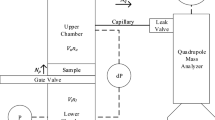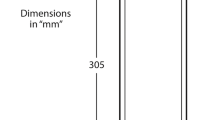Abstract
Detection of anthropogenic noble gas isotopes in the atmosphere is an important indication that a below ground nuclear-test has taken place. Diffusion plays a critical role in the transport of these gases through the geological media to the surface where they can be detected. Better techniques are need with which to study the diffusion of noble gases through porous systems. Here we demonstrate the suitability of using prompt gamma activation analysis to measure the time dependent concentration of argon as a result of its diffusion through a porous medium that is saturated with nitrogen at atmospheric pressure. The experiments were conducted in a 1 m long tube, 10 cm diameter, and packed with fine SiO2 sand. Prompt gamma activation analysis was used to measure the concentration of argon within the experimental system as a function of time.



Similar content being viewed by others
References
Auer M, Kumberg T, Sartorius H, Wernsperger B, Schlosser C (2010) Ten years of development of equipment for measurement of atmospheric radioactive xenon for the verification of the CTBT. Pure Appl Geophys 167(4):471–486
Zähringer M, Becker A, Nikkinen M, Saey P, Wotawa G (2009) CTBT radioxenon monitoring for verification: today’s challenges. J Radioanal Nucl Chem 282(3):737–742
Dresel P, Olsen K, Hayes J, McIntyre J, Waichler S, Kennedy B (2008) Environmental applications of stable xenon and radioxenon monitoring. J Radioanal Nucl Chem 276(3):763–769
Wotawa G, Becker A, Kalinowski M, Saey P, Tuma M, Zähringer M (2010) Computation and analysis of the global distribution of the radioxenon isotope 133Xe based on emissions from nuclear power plants and radioisotope production facilities and its relevance for the verification of the nuclear-test-ban treaty. Pure Appl Geophys 167(4):541–557
Bird RB, Stewart WE, Lightfoot EN (2007) Transport phenomena, 2nd edn. Willey, New York
Deen WM (1998) Analysis of transport phenomena. Topics in chemical engineering. Oxford University Press, Inc., New York
GarcÌa-GutiÈrrez M, Mingarro M, Missana T, MartÌn PL, Sedano LA, Cormenzana JL (2004) Diffusion experiments with compacted powder/pellets clay mixtures. Appl Clay Sci 26(1–4):57–64
Allaire SE, Lafond JA, Cabral AR, Lange SF (2008) Measurement of gas diffusion through soils: comparison of laboratory methods. J Environ Monit 10(11):1326–1336
Abu-El-Sha’r W, Abriola LM (1997) Experimental assessment of gas transport mechanisms in natural porous media: parameter evaluation. Water Resour Res 33(4):505–516
Rees KCJV, Sudicky EA, Rao PSC, Reddy R (1991) Evaluation of laboratory techniques for measuring diffusion coefficients in sediments. Environ Sci Technol 25(9):1605–1611
Takeda M, Nakajima H, Zhang M, Hiratsuka T (2008) Laboratory longitudinal diffusion tests: 1. Dimensionless formulations and validity of simplified solutions. J Contam Hydrol 97(3–4):117–134
Vaatainen K, Timonen J, Hautojarvi A (1993) Development of a gas method for migration studies in fractured and porous media. In: Proceedings of the 16th international symposium on the scientific basis for nuclear waste management (November 30, 1992–December 4, 1992, Boston. Materials research society symposium proceedings). Materials Research Society, pp 851–856
Currie JA (1960) Gaseous diffusion in porous media Part 1. A non-steady state method. Br J Appl Phys 11(8):314
Islas-Juarez R, Samanego-V F, Luna E, Perez-Rosales C, Cruz J Experimental study of effective diffusion in porous media. In: 2004 SPE international petroleum conference in Mexico (November 7, 2004–November 9, 2004, Puebla, Mexico). Society of Petroleum Engineers (SPE), London, pp 781–787
Rohling JH, Shen J, Wang C, Zhou J, Gu CE (2007) Determination of binary diffusion coefficients of gases using photothermal deflection technique. Appl Phys B 87(2):355–362
Takai S, Mandai T, Kawabata Y, Esaka T (2005) Diffusion coefficient measurements of La2/3–xLi3x TiO3 using neutron radiography. Solid State Ionics 176(29–30):2227–2233
Mair RW, Wong GP, Hoffmann D, Hurlimann MD, Patz S, Schwartz LM, Walsworth RL (1999) Probing porous media with gas diffusion NMR. Phys Rev Lett 83(16):3324
Mair RW, Rosen MS, Wang R, Cory DG, Walsworth RL (2002) Diffusion NMR methods applied to xenon gas for materials study. Magn Reson Chem 40:S29–S39
Pereira LM, Souza RD, Orlande HRB, Cotta RM (2001) A comparison of concentration measurement techniques for the estimation of the apparent mass diffusion coefficient. Braz J Chem Eng 18:253–265
Beyerle U, Aeschbach-Hertig W, Imboden DM, Baur H, Graf T, Kipfer R (2000) A mass spectrometric system for the analysis of noble gases and tritium from water samples. Environ Sci Technol 34(10):2042–2050
Mark DF, Stuart FM, de Podesta M (2011) New high-precision measurements of the isotopic composition of atmospheric argon. Geochim Cosmochim Acta 75(23):7494–7501
Technologies A (2001) Inductively coupled plasma mass spectrometry. Course Number H8974A. Agilent Technologies
Revay Z (2008) Prompt gamma activation analysis of samples in thick containers. J Radioanal Nucl Chem 276(3):825–830
Rios Perez C, Lowrey J, Biegalski S, Deinert M (2012) Xenon diffusion studies with prompt gamma activation analysis. J Radioanal Nucl Chem 291(1):261–265
Knoll G (2010) Radiation detection and measurement, 4th edn. Wiley, Hoboken
Harrison RK, Landsberger S (2009) Determination of boron over a large dynamic range by prompt-gamma activation analysis. Nucl Instrum Methods Phys Res Sect B 267(3):513–518
Rèvay Z, Harrison RK, Alvarez E, Biegalski SR, Landsberger S (2007) Construction and characterization of the redesigned PGAA facility at The University of Texas at Austin. Nucl Instrum Methods Phys Res Sect A 577(3):611–618
Currie LA (1968) Limits for qualitative detection and quantitative determination. Application to radiochemistry. Anal Chem 40(3):586–593
Currie LA (1995) Nomenclature in evaluation of analytical methods including detection and quantification capabilities. Pure Appl Chem 67(10):25
Biegalski SR, Green TC, Alvarez E, Aghara S (2007) Background characterization of The University of Texas PGAA facility. J Radioanal Nucl Chem 271(2):413–417
Molnar GL (ed) (2004) Handbook of prompt gamma activation analysis with neutron beams. Kluwer Academic Publishers, Dordrecht
Figliola RS, Beasley DE (2000) Theory and design for mechanical measurements, 3rd edn. Wiley, New York
Acknowledgments
The authors would like to thank Dr. Carlos Hidrovo for discussions about diffusion of gases through porous media, and the staff of the Nuclear Engineering Teaching Laboratory for their help with the prompt gamma measurements. This material is based upon work supported by the Department of Energy, National Nuclear Security Administration under Award Number DE-AC52-09NA28608.
Disclaimer
This report was prepared as an account of work sponsored by an agency of the United States Government. Neither the United States Government, nor any agency thereof, nor any of their employees, makes any warranty, expressed or implied, or assumes any legal liability or responsibility for the accuracy, completeness, or usefulness of any information, apparatus, product, or process disclosed, or represents that its use would infringe privately owned rights. Reference herein to any specific commercial product, process, or service by name, trademark, manufacturer, or otherwise does not necessarily constitute or imply its endorsement, recommendation or favoring buy the United States Government or any agency thereof. The views and opinions of authors expressed herein do not necessarily state or reflect those of the United States Government or any agency thereof.
Author information
Authors and Affiliations
Corresponding author
Rights and permissions
About this article
Cite this article
Rios Perez, C.A., Biegalski, S. & Deinert, M.R. Measuring the diffusion of noble gases through a porous medium using prompt gamma activation analysis. J Radioanal Nucl Chem 296, 951–956 (2013). https://doi.org/10.1007/s10967-012-2003-8
Received:
Published:
Issue Date:
DOI: https://doi.org/10.1007/s10967-012-2003-8




